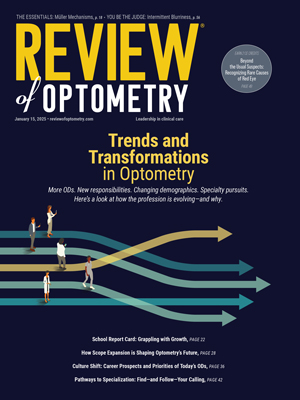|
Semaglutide and other GLP-1 agonists may have a beneficial effect on endothelial cells and antioxidant pathways, which could be the reason for their protective effect against DME development, the researchers suggested. Photo: Jay Haynie, OD. Click image to enlarge. |
As the number of adults with type 2 diabetes mellitus grows, so does the incidence of diabetic macular edema (DME). Recent drug approvals for diabetes have made notable strides against the systemic condition; does this carry forward to protection against its ocular consequences? Specifically, the drug semaglutide, a glucagon-like peptide-1 (GLP-1) for type 2 diabetes, has sparked interest in its broader impact on diabetic eye complications.
In a recent study conducted in Texas, researchers aimed to assess the impact of systemic medications, including GLP-1 receptor agonists, fenofibrates, thiazolidinediones and calcium channel blockers on the risk of developing DME in patients with type 2 diabetes. They found patients on GLP-1 agonists and fenofibrates each experienced a lower risk of DME diagnosis, while those on calcium channel blockers experienced an increased risk. The team’s paper on the work was recently published in Ophthalmology Retina.
In this retrospective cohort study, data from over 200,000 type 2 diabetes patients who were newly initiated on GLP-1 agonists, fenofibrates, thiazolidinediones or calcium channel blockers were included; the researchers looked at follow-up records for one to two years post-medication initiation to determine the rates of DME development. The study used propensity score matching (controls) to adjust for baseline characteristics and comorbidities.
The study found that patients on GLP-1 drugs and fenofibrates experienced a lower risk of DME diagnosis (hazard ratios of 0.77 and 0.83, respectively), suggesting a protective effect against DME development, while those on calcium channel blockers experienced an increased risk (HR: 1.66).
One member of the GLP-1 receptor agonist class, semaglutide, recently received an FDA label to reduce the risk of cardiovascular death, heart attack and stroke in adults with cardiovascular disease and either obesity or overweight status. A mouse model suggested beneficial effects of semaglutide on endothelial cells and antioxidant pathways, and identified differential regulation of T cells and interferon-γ. The authors suggest this could be the reason for the protective effect of GLP-1 medications on DME development.
Hence, in addition to enhanced blood glucose control, the researchers explained in their paper, GLP-1 receptor agonist therapy may confer additional benefits. They noted that a literature review “shows an absence of basic science investigation on the effect” of such meds on retinal cells and retinal metabolic pathways. “Hopefully, this finding of a potentially protective clinical effect will stimulate a focus on this potentially rewarding avenue of basic science study.”
Regarding the adverse effect of calcium channel blockers on DME development, studies have shown increased peripheral extremity edema in patients taking these drugs. “The mechanism of peripheral edema is unknown but may share vascular regulatory pathways with DME,” the authors wrote, as the meds “may increase VEGF concentrations in retinal cells.” Since millions of patients with diabetes take calcium channel blockers, “even a small differential risk in DME development could translate to a significant DME disease burden,” they wrote.
“Further research is needed to elucidate the mechanisms underlying these associations, determining whether the observed effects are due to the direct pharmacological impact of the drugs or the improved systemic control achieved by their use,” the authors concluded. “Additionally, further study of the effect of these systemic medications on retinal cells, retinal metabolism and clinical behavior of DME is warranted. Enhanced systemic management may prove less burdensome and more cost effective than high frequency intravitreal anti-VEGF therapy while also reducing non-ocular morbidity and mortality.”
| Click here for journal source. |
Muayad J, Loya A, Hussain ZS, et al. Influence of common medications on diabetic macular edema in type 2 diabetes. December 3, 2024. Ophthalmology Retina. [Epub ahead of print.] |


